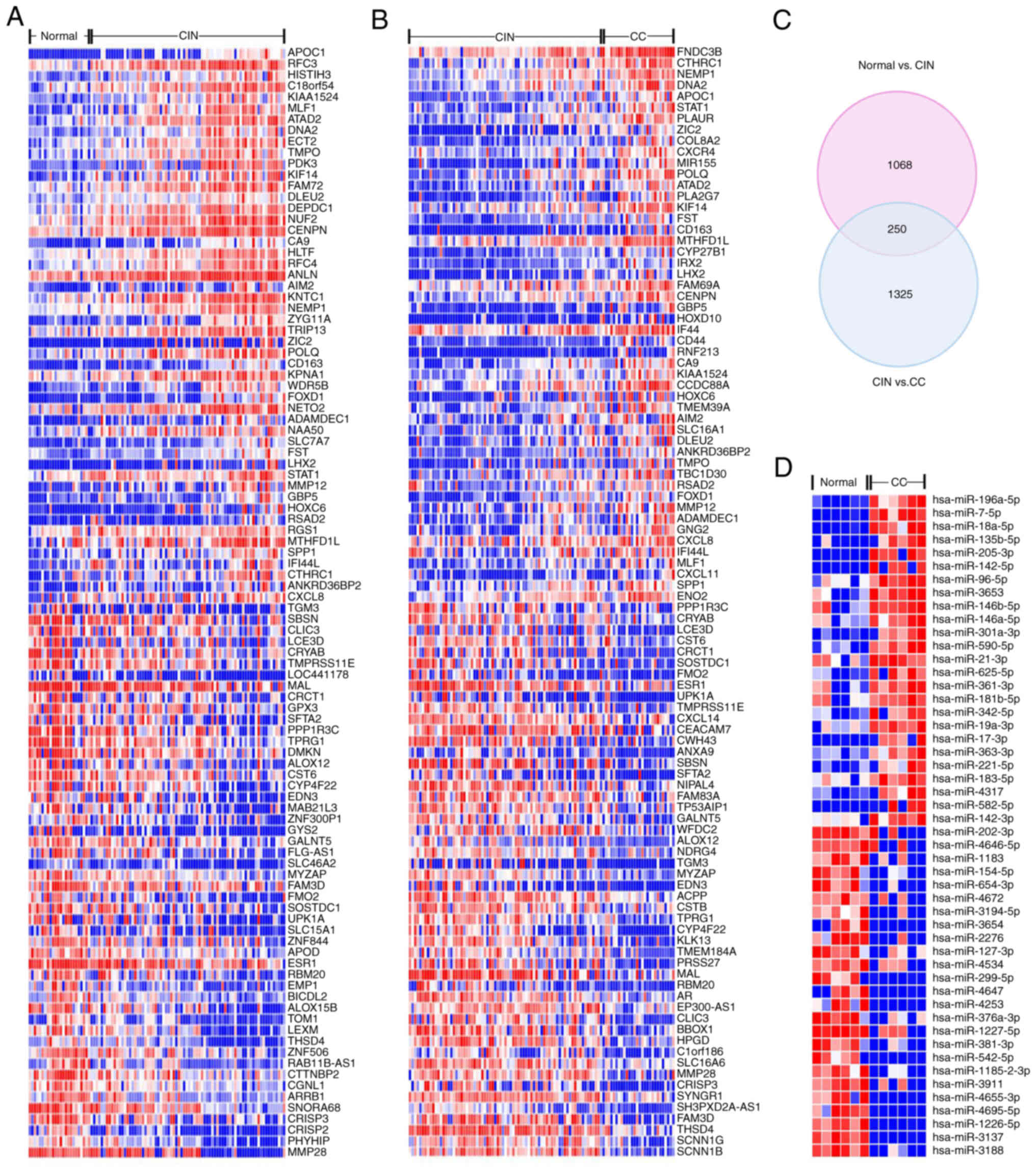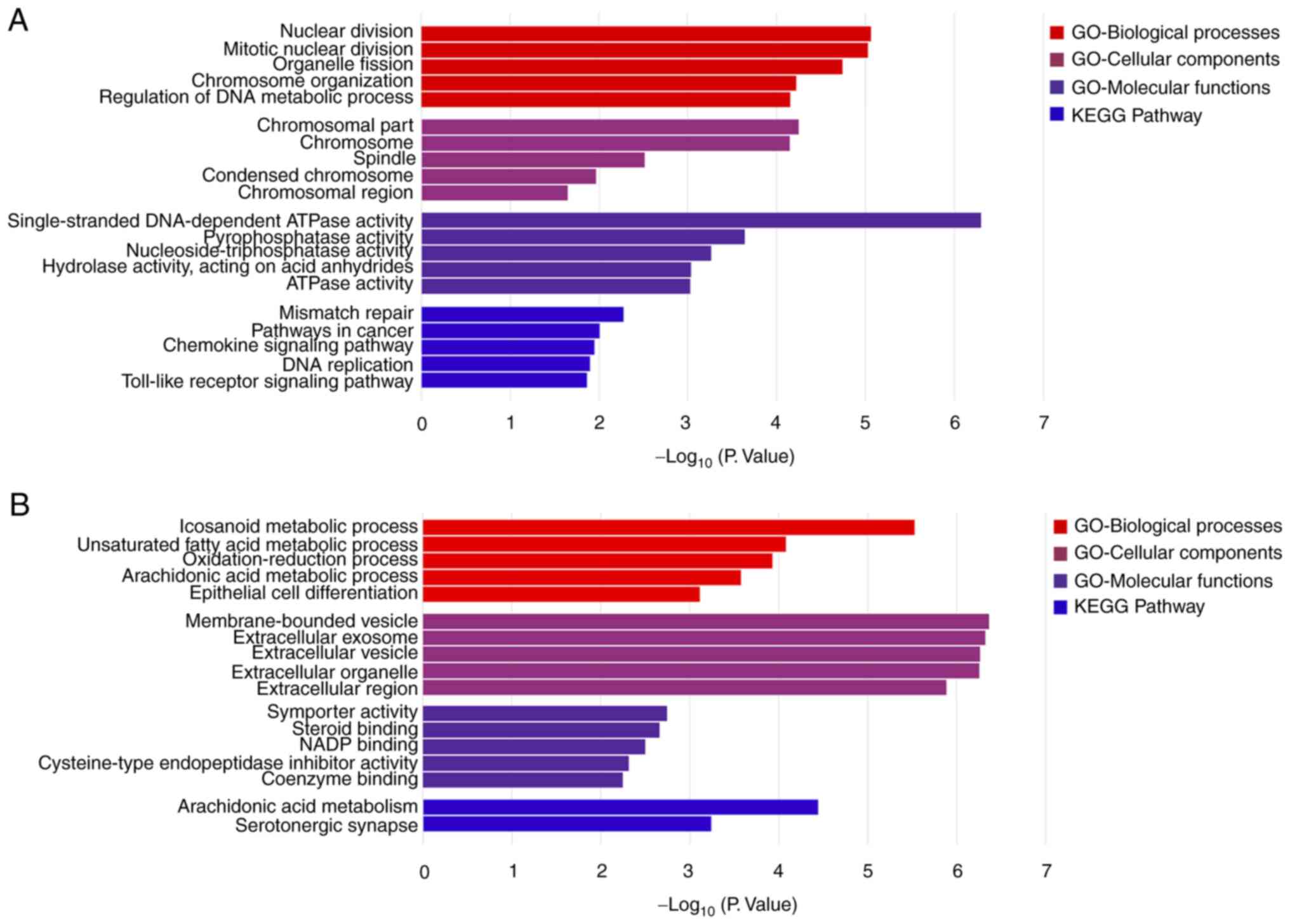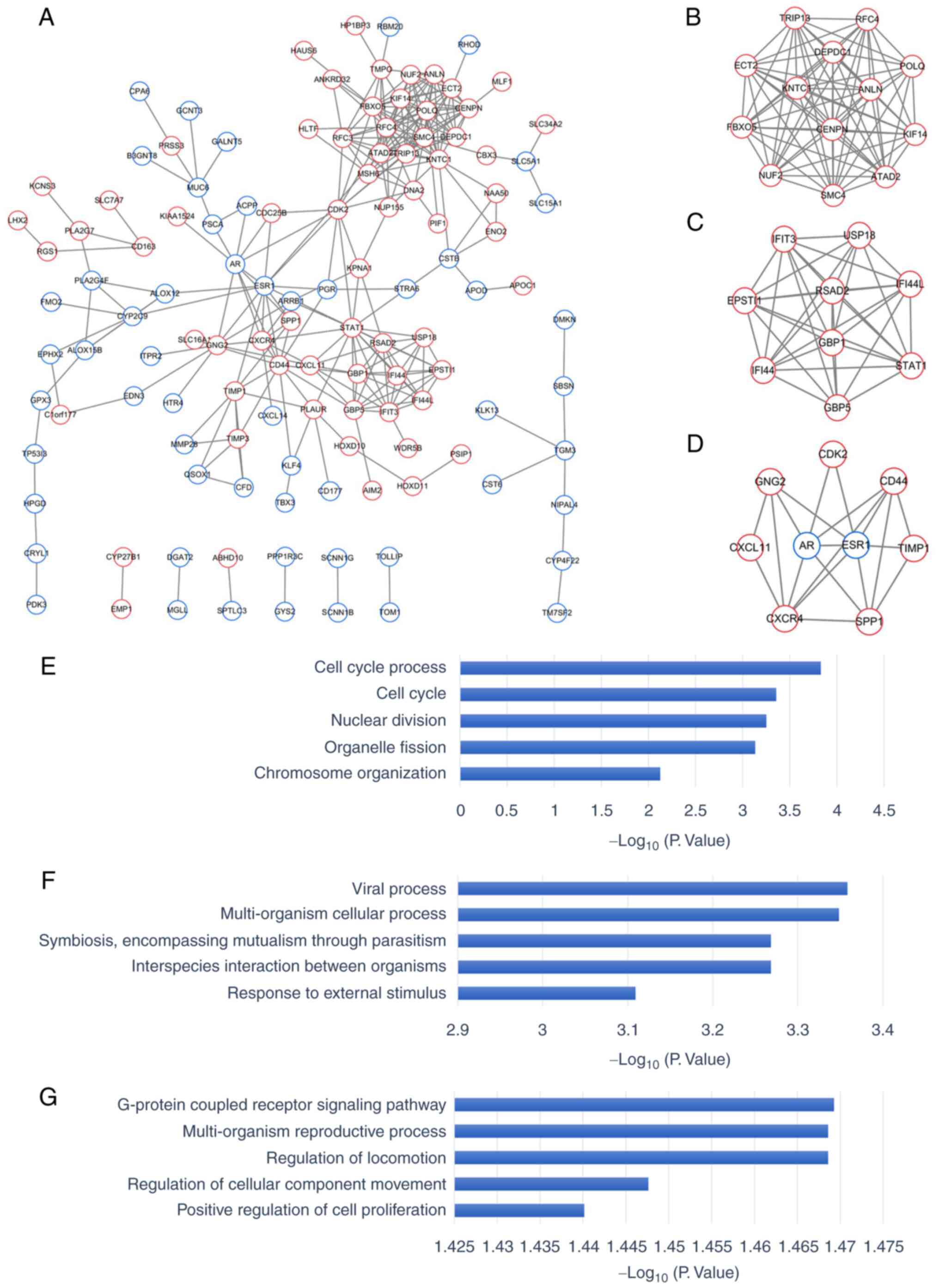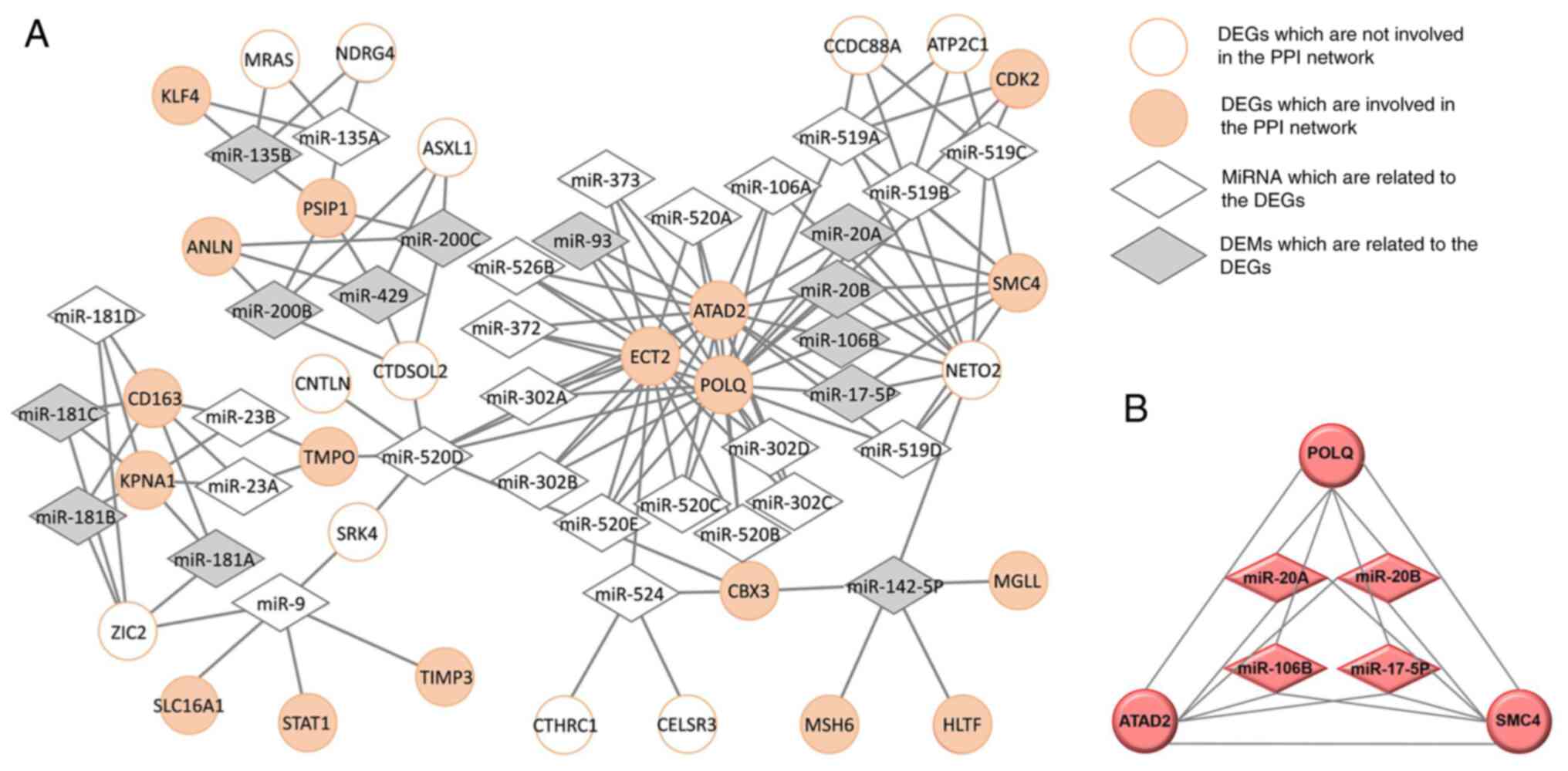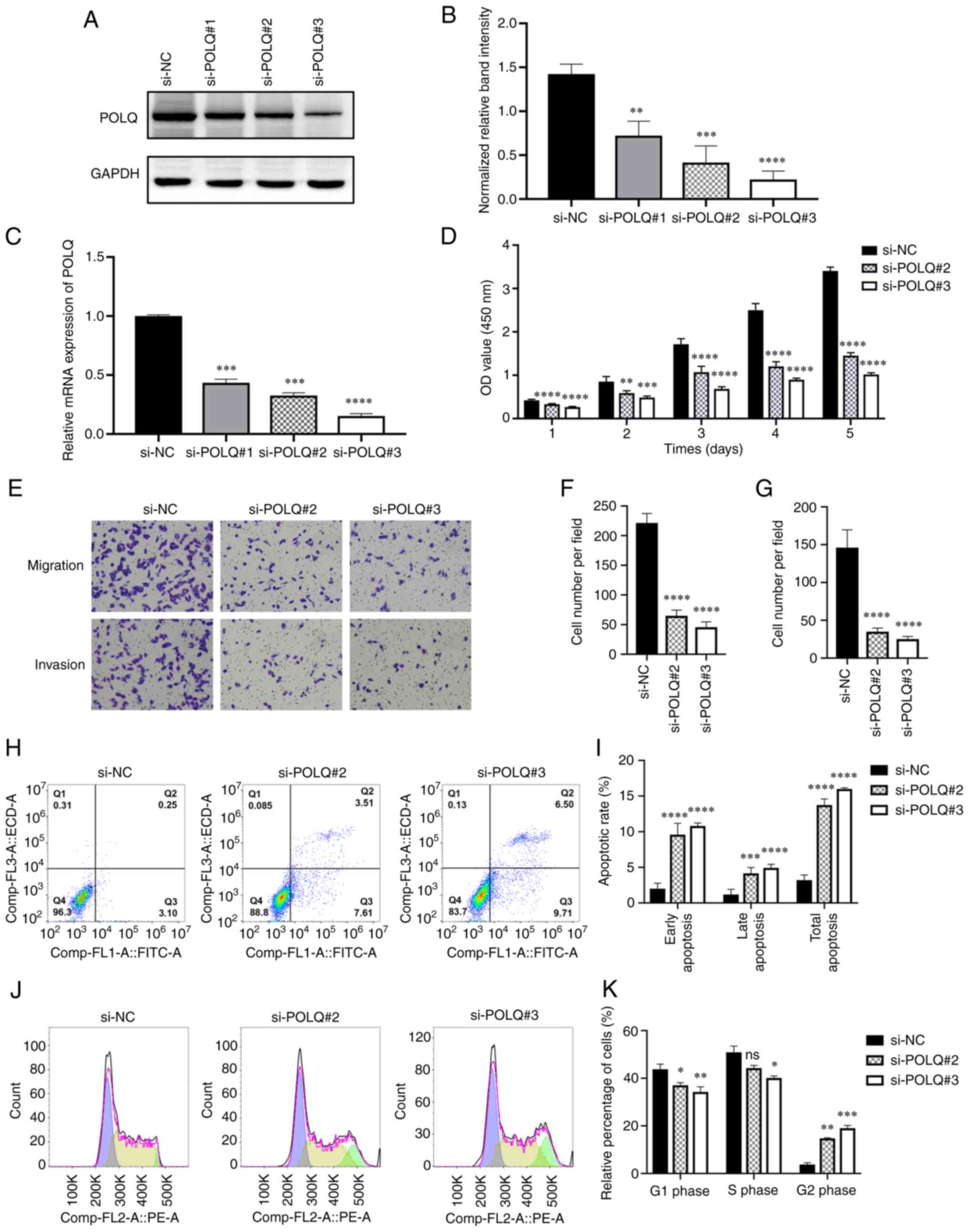|
1
|
Sung H, Ferlay J, Siegel RL, Laversanne M,
Soerjomataram I, Jemal A and Bray F: Global cancer statistics 2020:
GLOBOCAN Estimates of Incidence and Mortality Worldwide for 36
Cancers in 185 Countries. CA Cancer J Clin. 71:209–249. 2021.
View Article : Google Scholar : PubMed/NCBI
|
|
2
|
Wang T, Gong M, Cao Y, Zhao C, Lu Y, Zhou
Y, Yao S, Chen J, Zhao C and Ju R: Persistent ferroptosis promotes
cervical squamous intraepithelial lesion development and
oncogenesis by regulating KRAS expression in patients with high
risk-HPV infection. Cell Death Discov. 8:2012022. View Article : Google Scholar : PubMed/NCBI
|
|
3
|
Sun J, Yue Y, Li R, Sun Q, Hu C, Ge X and
Guan Q: Detection of HPV E6/E7 mRNA in the diagnosis of cervical
cancer and precancerous lesions after kidney transplantation. Am J
Transl Res. 13:7312–7317. 2021.PubMed/NCBI
|
|
4
|
Schmittgen TD and Livak KJ: Analyzing
real-time PCR data by the comparative C(T) method. Nat Protoc.
3:1101–1108. 2008. View Article : Google Scholar : PubMed/NCBI
|
|
5
|
Yuan Y, Shi X, Li B, Peng M, Zhu T, Lv G,
Liu L, Jin H, Li L and Qin D: Integrated analysis of key microRNAs
/TFs /mRNAs/ in HPV-positive cervical cancer based on microRNA
sequencing and bioinformatics analysis. Pathol Res Pract.
216:1529522020. View Article : Google Scholar : PubMed/NCBI
|
|
6
|
S D A, . Pasumarthi D, Pasha A, Doneti R B
S, Botlagunta M, B VL and Pawar SC: Identification of
differentially expressed genes in cervical cancer patients by
comparative transcriptome analysis. Biomed Res Int.
2021:88100742021.PubMed/NCBI
|
|
7
|
He H, Zheng C and Tang Y: Overexpression
of SMC4 predicts a poor prognosis in cervical cancer and
facilitates cancer cell malignancy phenotype by activating NF-κB
pathway. Hum Cell. 34:1888–1898. 2021. View Article : Google Scholar : PubMed/NCBI
|
|
8
|
Huang K, Jia J, Wu C, Yao M, Li M, Jin J,
Jiang C, Cai Y, Pei D, Pan G and Yao H: Ribosomal RNA gene
transcription mediated by the master genome regulator protein
CCCTC-binding factor (CTCF) is negatively regulated by the
condensin complex. J Biol Chem. 288:26067–26077. 2013. View Article : Google Scholar : PubMed/NCBI
|
|
9
|
Yi Y, Liu Y, Wu W, Wu K and Zhang W:
Reconstruction and analysis of circRNA-miRNA-mRNA network in the
pathology of cervical cancer. Oncol Rep. 41:2209–2225.
2019.PubMed/NCBI
|
|
10
|
Zheng L, Li T, Zhang Y, Guo Y, Yao J, Dou
L and Guo K: Oncogene ATAD2 promotes cell proliferation, invasion
and migration in cervical cancer. Oncol Rep. 33:2337–2344. 2015.
View Article : Google Scholar : PubMed/NCBI
|
|
11
|
Liu X: Up-regulation of miR-20a by HPV16
E6 exerts growth-promoting effects by targeting PDCD6 in cervical
carcinoma cells. Biomed Pharmacother. 102:996–1002. 2018.
View Article : Google Scholar : PubMed/NCBI
|
|
12
|
Zheng ZM and Wang X: Regulation of
cellular miRNA expression by human papillomaviruses. Biochim
Biophys Acta. 1809:668–677. 2011. View Article : Google Scholar : PubMed/NCBI
|
|
13
|
Honegger A, Schilling D, Bastian S,
Sponagel J, Kuryshev V, Sültmann H, Scheffner M, Hoppe-Seyler K and
Hoppe-Seyler F: Dependence of intracellular and exosomal microRNAs
on viral E6/E7 oncogene expression in HPV-positive tumor cells.
PLoS Pathog. 11:e10047122015. View Article : Google Scholar : PubMed/NCBI
|
|
14
|
Cheng Y, Geng L, Zhao L, Zuo P and Wang J:
Human papillomavirus E6-regulated microRNA-20b promotes invasion in
cervical cancer by targeting tissue inhibitor of metalloproteinase
2. Mol Med Rep. 16:5464–5470. 2017. View Article : Google Scholar : PubMed/NCBI
|
|
15
|
Palou R, Dhanaraman T, Marrakchi R,
Pascariu M, Tyers M and D'Amours D: Condensin ATPase motifs
contribute differentially to the maintenance of chromosome
morphology and genome stability. PLoS Biol. 16:e20039802018.
View Article : Google Scholar : PubMed/NCBI
|
|
16
|
Fukuhisa H, Seki N, Idichi T, Kurahara H,
Yamada Y, Toda H, Kita Y, Kawasaki Y, Tanoue K, Mataki Y, et al:
Gene regulation by antitumor miR-130b-5p in pancreatic ductal
adenocarcinoma: The clinical significance of oncogenic EPS8. J Hum
Genet. 64:521–534. 2019. View Article : Google Scholar : PubMed/NCBI
|
|
17
|
Yan Y, Liu C, Zhang J, Li W, Yin X, Dong
L, Pang S and Li X: SMC4 knockdown inhibits malignant biological
behaviors of endometrial cancer cells by regulation of FoxO1
activity. Arch Biochem Biophys. 712:1090262021. View Article : Google Scholar : PubMed/NCBI
|
|
18
|
Zhang C, Kuang M, Li M, Feng L, Zhang K
and Cheng S: SMC4, which is essentially involved in lung
development, is associated with lung adenocarcinoma progression.
Sci Rep. 6:345082016. View Article : Google Scholar : PubMed/NCBI
|
|
19
|
You A, Rao G, Wang J, Li J, Zhang Y, Gu J,
Ge X, Zhang K, Gao X, Wu X, et al: MiR-433-3p restrains the
proliferation, migration and invasion of glioma cells via targeting
SMC4. Brain Res. 1767:1475632021. View Article : Google Scholar : PubMed/NCBI
|
|
20
|
Nayak A, Dutta M and Roychowdhury A:
Emerging oncogene ATAD2: Signaling cascades and therapeutic
initiatives. Life Sci. 276:1193222021. View Article : Google Scholar : PubMed/NCBI
|
|
21
|
Dutta M, Das B, Mohapatra D, Behera P,
Senapati S and Roychowdhury A: MicroRNA-217 modulates pancreatic
cancer progression via targeting ATAD2. Life Sci. 301:1205922022.
View Article : Google Scholar : PubMed/NCBI
|
|
22
|
Zhang MJ, Zhang CZ, Du WJ, Yang XZ and
Chen ZP: ATAD2 is overexpressed in gastric cancer and serves as an
independent poor prognostic biomarker. Clin Transl Oncol.
18:776–781. 2016. View Article : Google Scholar : PubMed/NCBI
|
|
23
|
Liu Q, Liu H, Li L, Dong X, Ru X, Fan X,
Wen T and Liu J: ATAD2 predicts poor outcomes in patients with
ovarian cancer and is a marker of proliferation. Int J Oncol.
56:219–231. 2020.PubMed/NCBI
|
|
24
|
Hou M, Huang R, Song Y, Feng D, Jiang Y
and Liu M: ATAD2 overexpression is associated with progression and
prognosis in colorectal cancer. Jpn J Clin Oncol. 46:222–227. 2016.
View Article : Google Scholar : PubMed/NCBI
|
|
25
|
Cao LJ, Zhang YJ, Dong SQ, Li XZ, Tong XT,
Chen D, Wu ZY, Zheng XH, Xue WQ, Jia WH and Zhang JB: ATAD2
interacts with C/EBPβ to promote esophageal squamous cell carcinoma
metastasis via TGF-β1/Smad3 signaling. J Exp Clin Cancer Res.
40:1092021. View Article : Google Scholar : PubMed/NCBI
|
|
26
|
Hussain M, Zhou Y, Song Y, Hameed HMA,
Jiang H, Tu Y and Zhang J: ATAD2 in cancer: A pharmacologically
challenging but tractable target. Expert Opin Ther Targets.
22:85–96. 2018. View Article : Google Scholar : PubMed/NCBI
|
|
27
|
Haitani T, Kobayashi M, Koyasu S, Akamatsu
S, Suwa T, Onodera Y, Nam JM, Nguyen PTL, Menju T, Date H, et al:
Proteolysis of a histone acetyl reader, ATAD2, induces
chemoresistance of cancer cells under severe hypoxia by inhibiting
cell cycle progression in S phase. Cancer Lett. 528:76–84. 2022.
View Article : Google Scholar : PubMed/NCBI
|
|
28
|
Sun W, Lan X, Zhang H, Wang Z, Dong W, He
L, Zhang T, Zhang P, Liu J and Qin Y: NEAT1_2 functions as a
competing endogenous RNA to regulate ATAD2 expression by sponging
microRNA-106b-5p in papillary thyroid cancer. Cell Death Dis.
9:3802018. View Article : Google Scholar : PubMed/NCBI
|
|
29
|
Wang Z, Song Y, Li S, Kurian S, Xiang R,
Chiba T and Wu X: DNA polymerase θ (POLQ) is important for repair
of DNA double-strand breaks caused by fork collapse. J Biol Chem.
294:3909–3919. 2019. View Article : Google Scholar : PubMed/NCBI
|
|
30
|
Pan Q, Wang L, Liu Y, Li M, Zhang Y, Peng
W, Deng T, Peng ML, Jiang JQ, Tang J, et al: Knockdown of POLQ
interferes the development and progression of hepatocellular
carcinoma through regulating cell proliferation, apoptosis and
migration. Cancer Cell Int. 21:4822021. View Article : Google Scholar : PubMed/NCBI
|
|
31
|
Shinmura K, Kato H, Kawanishi Y, Yoshimura
K, Tsuchiya K, Takahara Y, Hosokawa S, Kawase A, Funai K and
Sugimura H: POLQ overexpression is associated with an increased
somatic mutation load and PLK4 overexpression in lung
adenocarcinoma. Cancers (Basel). 11:7222019. View Article : Google Scholar : PubMed/NCBI
|
|
32
|
Lemée F, Bergoglio V, Fernandez-Vidal A,
Machado-Silva A, Pillaire MJ, Bieth A, Gentil C, Baker L, Martin
AL, Leduc C, et al: DNA polymerase theta up-regulation is
associated with poor survival in breast cancer, perturbs DNA
replication, and promotes genetic instability. Proc Natl Acad Sci
USA. 107:13390–13395. 2010. View Article : Google Scholar : PubMed/NCBI
|
|
33
|
Pillaire MJ, Selves J, Gordien K, Gourraud
PA, Gentil C, Danjoux M, Do C, Negre V, Bieth A, Guimbaud R, et al:
A ‘DNA replication’ signature of progression and negative outcome
in colorectal cancer. Oncogene. 29:876–887. 2010. View Article : Google Scholar : PubMed/NCBI
|
|
34
|
Allera-Moreau C, Rouquette I, Lepage B,
Oumouhou N, Walschaerts M, Leconte E, Schilling V, Gordien K,
Brouchet L, Delisle MB, et al: DNA replication stress response
involving PLK1, CDC6, POLQ, RAD51 and CLASPIN upregulation
prognoses the outcome of early/mid-stage non-small cell lung cancer
patients. Oncogenesis. 1:e302012. View Article : Google Scholar : PubMed/NCBI
|
|
35
|
Yousefzadeh MJ and Wood RD: DNA polymerase
POLQ and cellular defense against DNA damage. DNA Repair (Amst).
12:1–9. 2013. View Article : Google Scholar : PubMed/NCBI
|
|
36
|
Guo J, Jiang Z, Li X, Wang X and Xiao Y:
miR-20b downregulates polymerases κ and θ in XP-V tumor cells.
Oncol Lett. 11:3790–3794. 2016. View Article : Google Scholar : PubMed/NCBI
|















